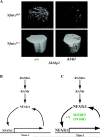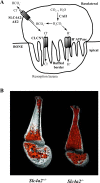Transcriptional regulation of bone and joint remodeling by NFAT
- PMID: 20193006
- PMCID: PMC2904911
- DOI: 10.1111/j.0105-2896.2009.00849.x
Transcriptional regulation of bone and joint remodeling by NFAT
Abstract
Osteoporosis and arthritis are highly prevalent diseases and a significant cause of morbidity and mortality worldwide. These diseases result from aberrant tissue remodeling leading to weak, fracture-prone bones or painful, dysfunctional joints. The nuclear factor of activated T cells (NFAT) transcription factor family controls diverse biologic processes in vertebrates. Here, we review the scientific evidence that links NFAT-regulated gene transcription to bone and joint pathology. A particular emphasis is placed on the role of NFATs in bone resorption and formation by osteoclasts and osteoblasts, respectively. In addition, emerging data that connect NFATs with cartilage biology, angiogenesis, nociception, and neurogenic inflammation are explored. The goal of this article is to highlight the importance of tissue remodeling in musculoskeletal disease and situate NFAT-driven cellular responses within this context to inspire future research endeavors.
Figures



References
-
- Harris ED., Jr The bone and joint decade: a catalyst for progress. Arthritis Rheum. 2001;44:1969–1970. - PubMed
-
- Karsenty G, Wagner EF. Reaching a genetic and molecular understanding of skeletal development. Dev Cell. 2002;2:389–406. - PubMed
-
- Phillips K, Aliprantis A, Coblyn J. Strategies for the prevention and treatment of osteoporosis in patients with rheumatoid arthritis. Drugs Aging. 2006;23:773–779. - PubMed
Publication types
MeSH terms
Substances
Grants and funding
LinkOut - more resources
Full Text Sources
Medical

